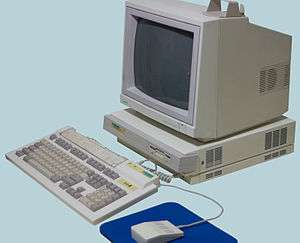Acorn Archimedes
 | |
|
Archimedes 400/1 series computer: note the standard grey function keys on the keyboard; on BBC branded models, the function keys were red | |
| Developer | Acorn Computers Ltd |
|---|---|
| Type | Personal computer or home computer |
| Generation | Fourth generation |
| Release date | June 1987 |
| Introductory price | 800 GBP (circa 2,000 GBP today) |
| Discontinued | Mid-1990s |
| Operating system | RISC OS or RISC iX |
| CPU | ARM |
| Memory | 512 kB–16 MB |
The Acorn Archimedes is a family of personal computers designed by Acorn Computers Ltd in Cambridge, England and sold in the late-1980s to mid-1990s, their first general purpose home computer based on their own ARM architecture (then the CPU and architecture was known as Acorn RISC Machine, or ARM, that later became one of the most widely used CPU architectures in the world,[1] e.g. used in most smartphones). The first Archimedes was launched in 1987.
ARM's RISC design – 32-bit CPU (26-bit addressing), running at 8 MHz, was stated as running at 4.5+ MIPS,[2] which provided a significant upgrade from 8-bit home computers, such as Acorn's previous ones. Claims of being the fastest micro in the world and running at 18 MIPS were also made during tests.[3]
The models in the family either omitted the Acorn or Archimedes part of the name, with the first models named "BBC Archimedes", while the name "Acorn Archimedes" is commonly used to describe any of Acorn's contemporary designs based on the same architecture. While the computers are no longer sold, computers such as the Raspberry Pi can still run its operating system, RISC OS (at least later versions) as they use ARM chips that are (mostly) compatible.
Description and history
Early models

The Acorn Archimedes was the first RISC-based home computer.[4] The first models were released in June 1987, as the 300 and 400 series. The 400 series included four expansion slots (although a two slot backplane could be added to the 300 series as an official upgrade, and third parties produced their own 4-slot backplanes) and an ST506 controller for an internal hard drive. Both models included the Arthur operating system (later replaced by RISC OS as a paid-for upgrade), BBC BASIC programming language and an emulator for Acorn's earlier BBC Micro, and were mounted in two-part cases with a small central unit, monitor on top, and a separate keyboard and three-button mouse (the middle one, used for pop-up context menus of the operating system). All models featured eight channel 8-bit stereo sound (time-multiplexed in software to the one channel the hardware provided, with the software also providing volume control – that was easier – as the sound was logarithmic) and were capable of displaying 256 colours on screen.[5]
Four models were initially released with different amounts of memory, the A305, A310, A410 and A440. The 540 was unveiled in September 1990, and included higher speed SCSI and provision for connecting Genlock devices.[6] The 300 and 400 were followed by a number of machines with minor changes and upgrades:
A3000 and A5000
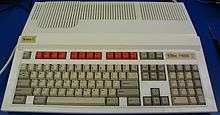
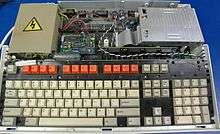
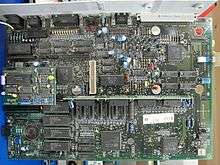
Work began on a successor to the Arthur operating system. Initially named Arthur 2, it was renamed to RISC OS 2. New computers were shipped with it pre-installed. A number of new machines were introduced along with RISC OS 2 and in May 1989, the 300 series was phased out in favour of the new Acorn A3000 (the 400 series was kept in production). Earlier models which shipped with Arthur could be upgraded to RISC OS 2 by replacing the ROM chips containing the operating system.
The A3000 used an 8 MHz ARM2 and was supplied with 1 MB of RAM. Unlike the previous models, the A3000 came in a single-part case similar to the BBC Micro, Amiga 500 and Atari ST computers, with the keyboard integrated in the base unit. This kind of housing consumes a lot of desktop space, a problem that Acorn tried to overcome by offering a monitor stand that attached to the base unit.[7] The new model sported only a single internal expansion slot, which was physically different from that of the earlier models, although electronically similar. An external connector could interface to existing expansion cards, although they really needed to be housed in an external case joined to the main unit.
A300 series, A400 series, R140 and A3000 machines had the VIDC1a video chip, which provided a wide variety of screen resolutions, such as those provided officially be the operating system:
- 160 × 256 with 4, 16 or 256 possible colours
- 320 × 256 with 2, 4, 16 or 256 possible colours
- 640 × 256 with 2, 4, 16 or 256 possible colours
- 640 × 512 with 2, 4, 16 or 256 possible colours
- 800 × 600 with 2, 4 or 16 possible colours
while the chip could be made to run others, such as:
- 1152 × 896[8] with 2 possible colours
where the palette range was 4096 colours (12-bit) and the VIDC1a had 16 hardware palette registers. This meant that in screen modes with sixteen colours or fewer, the colours could be mapped to any of the 4096 available. However, in 256 colour modes, 4 bits of the colour data were hardware derived and could not be adjusted. The net result was 256 colours, but only 16 of them could be assigned as desired, covering a range of the 4096 available colours.[9] It also had no Horizontal sync interrupt, meaning that it was difficult to display additional colours by changing the palette for each scan line, but not impossible, thanks to the 2 MHz IOC timer 1.[10] Many demos managed to display 4096 colour on screen or more with dithering[11] It had also one hardware sprite, with 32 pixels width and unlimited height (by default used for the mouse pointer), where each pixel is coded on two bits: value 0 is for transparency, and the three others are freely chosen from the 4096 colour palette.[12][13]
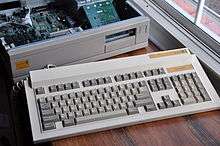
In 1991, the A5000 was launched. It featured the new 25 MHz ARM3 processor, 2 or 4 MB of RAM, either a 40 MB or an 80 MB hard drive and a more conventional pizza box-style two-part case (HxWxD: 100 mm × 430 mm × 340 mm[14]). Its enhanced video capabilities allowed the A5000 to comfortably display VGA resolutions of up to 800×600 pixels. It was the first Archimedes to feature a High Density capable floppy disc drive as standard. This natively supported various formats including DOS and Atari discs. A later version of the A5000 featured a 33 MHz ARM3, 4 or 8 MB of RAM, an 80 or 120 MB hard drive.
The A5000 initially ran the new 3.0 version of RISC OS, although several bugs were identified; most were shipped with RISC OS 3.10 or 3.11. As before, earlier machines were capable of being upgraded to the new RISC OS 3, though some needed an additional daughterboard installing first.[15] Earlier models could also benefit from the video performance of the A5000 via a third party upgrade.[16]
New range and a laptop
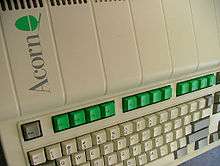
In 1992, a new range was produced, utilising the first ARM macrocell: the ARM250 microprocessor, a single-chip design including the functionality of an ARM3 chip without cache, the IOC1 (Input Output Controller), VIDC1a (VIDeo and sound Controller) and MEMC1 (MEMory Controller) chips all integrated into one chip. The increase in clock frequency, from 8 MHz to 12 MHz, gave a performance of 7 MIPS. The machines were supplied with RISC OS 3.10 or 3.11. The A30x0 series had a one-piece design, similar to the A3000 but far smaller, while the A4000 looked like a slightly slimmer A5000. The A3010 model was intended to be a home computing machine, featuring a TV modulator and standard 9-pin joystick ports, while the A3020 targeted the home office and educational markets, featuring a built-in 2.5" hard drive and a dedicated network interface socket. Technically, the A4000 was almost identical to the A3020, only differing in hard disk size (3.5-inch in the A4000), though it sported a different appearance. All three ARM250-based machines could be upgraded to 4 MB with plug-in chips (though the A3010 was designed for 2 MB, third party upgrades overcame this) and one "mini-podule" slot as used for internal expansion in the A3000.
Also in 1992, Acorn introduced the A4 laptop computer featuring a slower 24 MHz (compared to the 25 MHz A5000) version of the ARM3 processor and a LCD screen capable of displaying a maximum resolution of 640 × 480 pixels in 15 levels of grey. However, it did feature a monitor port which offered the same display capabilities as an A5000. A notable omission from the machine was a built-in pointing device, requiring users to navigate with the cursor keys or attach a conventional Acorn three-button mouse.[17]
The A7000, despite its name being reminiscent of the Archimedes naming conventions, was actually more similar to the Risc PC, the line of RISC OS computers that succeeded the Archimedes in 1994. It lacked, however, the DEBI expansion slots and multi-slice case that characterized the RiscPC (though by removing the CDROM, a backplane with one slot could be fitted).
List of models
| Model | Memory (RAM) | Hard disk space | ARM processor (single core) | Launch date | UK retail price at launch | Notes |
|---|---|---|---|---|---|---|
| BBC Archimedes 305 | 512 KB (512 KB) | - | ARM2 | July 1987 | £799[18] | - |
| BBC Archimedes 310 | 1 MB (1 MB) | - | ARM2 | July 1987 | £875[18] | - |
| BBC Archimedes 310M | 1 MB | - | ARM2 | July 1987 | Unknown | Includes PC emulation software |
| Acorn Archimedes 410 | 1 MB | - | ARM2 | July 1987 | £1,399[18] | - |
| Acorn Archimedes 440 | 4 MB | 20 MB | ARM2 | July 1987 | £2,299[18] | - |
| BBC A3000 | 1 MB | - | ARM2 | May 1989 | £649[19] | This model was the last ever BBC Microcomputer |
| Acorn Archimedes 410/1 | 1 MB | - (ST506 interface on motherboard) | ARM2 | June 1989 | £999 | Improved MEMC1A memory controller over previous 410 model |
| Acorn Archimedes 420/1 | 2 MB | 20 MB ST506 | ARM2 | June 1989 | £1,099 | - |
| Acorn Archimedes 440/1 | 4 MB | 40 MB ST506 | ARM2 | June 1989 | £1,299 | Improved MEMC1A memory controller over previous 440 model |
| Acorn R140 | 4 MB | 47 MB ST506 | ARM2 | June 1989 | £3,500 | RISC iX workstation |
| Acorn Archimedes 540 | 4 MB (max. 16 MB) | 100 MB SCSI | ARM3 | June 1990 | £2,499 | |
| Acorn R225 | 4 MB | - | ARM3 | July 1990 | £3,000 | RISC iX network workstation |
| Acorn R260 | 8 MB | 100 MB SCSI | ARM3 | July 1990 | £5,000 | RISC iX workstation |
| Acorn A5000 | 1, 2, 4 or 8 MB | 20 MB to 160 MB IDE | ARM3 | September 1991 | £999 or £1,499 | 25 or 33 MHz ARM3 processor, launched with various sub-models |
| Acorn A4 | 2 or 4 MB | 40 or 60 MB IDE (2.5") | ARM3 | June 1992 | £1,399 or £1,699 | Notebook model with ARM3 processor clocked at 24 MHz, 640x480 greyscale LCD screen |
| Acorn A3010 | 1 MB | - | ARM2/ARM250 | September 1992 | £499 | ARM250 processor (early models had an ARM2 mezzanine processor codenamed "Adelaide"[20]) |
| Acorn A3020 | 2 MB | 0–80 MB IDE (2.5") | ARM250 | September 1992 | £799 | |
| Acorn A4000 | 2 MB | 0–210 MB IDE | ARM250 | September 1992 | £999 |
Also produced, but never sold commercially were:
- A500: 4 MB RAM, ST506 interface, Archimedes development machine[21]
- A680 and M4: 8 MB RAM, SCSI on motherboard, RISC iX development machines
Significance and impact
The Archimedes was one of the most powerful home computers available during the late 1980s and early 1990s; its main CPU was faster than the Motorola 68000 microprocessors found in the more popular Commodore Amiga and Atari ST machines. An 8 MHz 68000 had an average performance of roughly 1 MIPS for 16-bit workloads and 0.5 MIPS for 32-bit workloads, with peak performance of 2 MIPS for simpler 16-bit instructions. The 8 MHz ARM2 yielded 4.5 - 4.8 MIPS for 32-bit workloads in repeatable benchmark tests.[2] However, since the 68000 is a CISC and ARM2 is a RISC architecture, the 68000 could execute more complex instructions in one step, while the ARM2 must do it in several steps. So, depending on the task and the code, the 68000 may outperform the ARM2 in several cases.
The computer was exhibited at the 1987 Personal Computer World Show, along with Amigas, Atari STs and video game consoles. Commenting on the show, Crash magazine reported that "despite whiz-bang demos of Acorn’s Archimedes" the 8-bit machines were not dead.[22]
The Archimedes won significant market share in the education markets of the UK, Ireland, Australia and New Zealand; the success of the Archimedes in British schools was due partly to its predecessor the BBC Micro and later to the Computers for Schools scheme organised by the Tesco supermarket chain in association with Acorn, and most students and pupils in these countries in the early 90s were exposed to an Archimedes or A-series computer. The Archimedes range was available in the US and Canada via Olivetti Canada.[23]
By the early 1990s, the UK educational market began to turn away from the Archimedes. Apple Macintosh computers or IBM compatible PCs eclipsed the Archimedes in their multimedia capabilities, which led to an erosion of the Archimedes market share. The Tesco Computers for Schools scheme later changed partnership from Acorn to RM plc and many other computer-related suppliers, which also led to the decrease of the Archimedes' educational market share.
See also
- The Fourth Dimension (company)
- Category:Acorn Archimedes games
References
- ↑ Anand Lal Shimpi (March 31, 2014). "ARM Partners Ship 50 Billion Chips Since 1991 - Where Did They Go?".
ARM pointed out that Cortex-A shipments overtook x86 in 2012
- 1 2 "Chris's Acorns - RISC OS Performance Page". Acorn.chriswhy.co.uk. 2008-10-31. Archived from the original on 18 July 2011. Retrieved 2011-06-13.
- ↑ Hammond, Ray (1987-06-18). "'Fastest' micro in the world". New Scientist. p. 41.
- ↑ Pountain, Dick (October 1987). "The Archimedes A310". BYTE. p. 125. Retrieved 4 August 2014.
- ↑ Acorn Archimedes Promotion from 1987
- ↑ Williams, Mike; Wrigley, Alan (November 1990). "The RISC OS Time Machine — A £3000 computer". RISC User. RISC User. Retrieved 2011-06-08.
[...] further differences, one of major importance. This is the SCSI connector on the rear of the SCSI interface card [...] Internally, provision has also been made for Genlock and similar video digitiser boards to be connected directly into the Archimedes.
- ↑ Fred Harris Introduces the Acorn Archimedes BBC A3000 Part 1
- ↑ Daszkiewicz, Krzysztof; Wolski David (12 February 2014). "ARM kontra x86 - pojedynek technologii procesorowych". PC World (Poland). Retrieved 17 February 2014.
- ↑ Riscos : Specifications of Legacy RISC OS machines
- ↑ IOC Timer / IRQs - comp.sys.acorn.programmer | Google Groups
- ↑ ftp://arcade.demon.co.uk/flist.txt
- ↑ Retro Treasures: Acorn Archimedes A3000
- ↑ RISC OS News, Software and Information
- ↑ "A5000 Spec's". Classicacorn.freeuk.com. Retrieved 2011-06-13.
- ↑ "Chris's Acorns: 32bit Upgrades & Expansions by company". Acorn.chriswhy.co.uk. 2008-10-31. Archived from the original on 18 July 2011. Retrieved 2011-06-13.
- ↑ "Chris's Acorns: 32bit Upgrades & Expansions by company". Acorn.chriswhy.co.uk. 2008-10-31. Archived from the original on 18 July 2011. Retrieved 2011-06-13.
- ↑ Announcing Acorn's A4 Portable - "... a quart in a pint pot"
- 1 2 3 4 "300 SERIES A British Broadcasting Corporation Microcomputer" (PDF). Archimedes High Performance Computer Systems Retail Price List. July 1987.
- ↑ Cain, Chris (July 1989). "Acorn A3000". Personal Computer World.
- ↑ "A3010 Specs". Classicacorn.freeuk.com. Retrieved 2011-06-13.
- ↑ "Rare A500 surfaces on ebay | Drobe.co.uk archives". Drobe.co.uk. Archived from the original on 8 June 2011. Retrieved 2011-06-13.
- ↑ "News from the PCW Show". Crash. Newsfield Publications. November 1987. Archived from the original on 6 June 2011. Retrieved 2011-07-12.
Despite the number of STs and Amigas demonstrating titles at the show, despite whiz-bang demos of Acorn’s Archimedes, and despite the undeniable interest shown in the games machines, The PCW Show indicated to me that it’s a bit early to announce the death of the 8-bit machines.
- ↑ Roger Wilson (April 10, 1990). "Acorn Micros?". Newsgroup: comp.misc. Usenet: [email protected]. Retrieved June 14, 2011.
External links
| Wikimedia Commons has media related to Acorn Archimedes. |
- Acorn systems page at Old-Computers.com
- Acorn Archimedes at Flatbatteries
- Chris's Acorns: Archimedes
